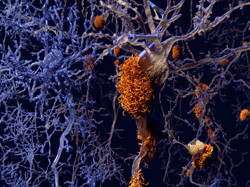Protein misfolding in neurodegeneration
The hallmark of many neurodegenerative disorders such as Alzheimer's and Parkinson's disease is the presence of protein aggregates known as amyloids. Amyloid fibrils emerge from the inappropriate folding of various proteins that erroneously interact with each other, causing significant pathologies. Scientists on the EU-funded FIBCAT project performed a detailed investigation to unravel the mechanism of amyloid formation and their structural features. They used the proteins Concanavalin A, insulin and Equine Lysozime as a model systems, and combined advanced microscopy with small angle X-ray scattering to characterise the aggregates. Researchers successfully obtained high-resolution information - almost to the level of the atom - of the early structural modifications implicated in protein aggregation. Such detailed knowledge is central for the design of inhibitors to treat neurodegenerative diseases. In addition, they generated data on the physical properties of amyloid structures, focusing on the role of water in inter-protein interactions, the kinetics of aggregation and the morphology of the final aggregates. Based on these mechanisms, the FIBCAT consortium went on to study the aggregation process for alpha-synuclein, the protein implicated in Parkinson's disease. They investigated the aggregation pathway and the disruptive capacity of various intermediates on biological membranes. They monitored in real time the interaction between protein and membrane to discover that intermediate products were as toxic as final aggregates. From a therapeutic perspective, researchers used the small molecule thioflavin-T to monitor different conformations and structural states of the protein as well as several fluorescent markers to identify physico-chemical properties of the aggregates. Interfering with the stability of the aggregated protein and preventing the toxic effects of amyloid fibrils open up novel avenues for treatment of neurodegenerative disorders. Given the detrimental effect of these conditions on the quality of life of patients and their families, the findings of the FIBCAT have great socioeconomic significance.







